|
Mk.I.
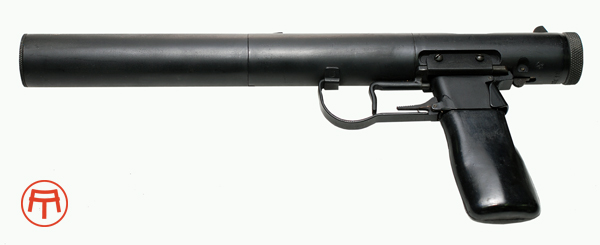 Welrod MkI. Caliber 9mm parabellum (Photo - Anders Thygesen courtesy of the Royal Armouries). Click for closeup photo of trigger group.
Welrod MkI. Caliber 9mm parabellum (Photo - Anders Thygesen courtesy of the Royal Armouries). Click for closeup photo of trigger group.
Alas I’ve been less successful in obtaining adequate information about the Mk I version. Still, I have enough for a reasonable description. I have the manuals for both the “Type A” and “Type B”, but to the best of my efforts there are no visible differences between the two. The difference is most likely in the internal suppressor tube construction. Differences in the end cap has been noticed however as some caps has a slot cut in the face allowing a tool to be insert to assist loosen or tightening the cap.
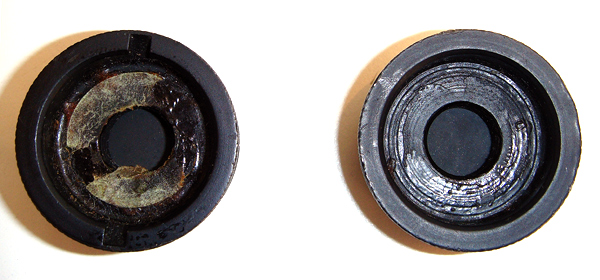
9mm Welrod Mk.I. suppressor end caps. Notice the one to the left with the slot cut in the face. This particular silencer has never been fired and there is still traces of glue and paper from the factory seal.
(Photo courtesy of INTAREX - The Netherlands)
In the manuals under FUNCTION, GENERAL DESCRIPTION and under NOTES ON USE texts are identical and read as follows:
FUNCTION:
The 9mm. Welrod is a silent single shot pistol, intended for use by specially trained operators for specific tasks.
GENERAL DESCRIPTION:
The weapon is a specially constructed single shot pistol with a detachable silencer. It is silent, reliable in action and easy to conceal. It is accurate up to 30 yards in daylight or 20 yards on a fairly light night, but is most effective when fired in contact with the target.
NOTES ON USE:
The gun has three distinct and separate uses:
a) For aimed and deliberate shots in daylight or darkness. The effective range of the gun with normal handling is 15/30 yards. For deliberate shots, extreme accuracy is required and can only be obtained by correct trigger squeeze, i.e. a gradual squeeze by the whole hand. With training and practice it is possible to obtain very accurate groups at the distances mentioned. The gun should be held with the thumb and forefinger of the left hand as close up to the muzzle as possible, the pistol grip being held by the right hand. For standing shots, the left elbow should be as close to the body as possible and the rear of the gun approximately 6”/7”from the operator´s eye.
b) Without its silencer and used as a single-shot weapon.
c) By use of the weapon at the closest quarters, i.e. with the muzzle against the target. For this purpose no special training is required.
The construction itself is practically identical to that of the Mk IIA with the exception of a few details. The grip safety is slightly different in appearance but functions in the exact same manner. Placed underneath the tube right behind the grip safety, a secondary manually operated safety catch has been added. The trigger and trigger-function remains the same, but is now protected by a trigger guard. The magazine release has, due to the previously mentioned problems on the Mk II and Mk IIA, been moved in front of the grip and inside the trigger guard. The magazine is most likely from a .38 Colt Automatic, and the manual directs that although the total capacity allows for 6 bullets, that only 5 be loaded. The true difference lies with the suppressor tube that is two-piece. The rear piece, as with Mk II and Mk IIA, contains the breech, barrel and expansion chamber, whereas the front piece contains the baffles and washers section. The front piece, detachable just in front of the front sight, has a length of 125 mm bringing the pistol to a total length of 360 mm. The tube diameter is 35 mm, and the weight of the pistol is 1500 grams which equals 53 ounce.
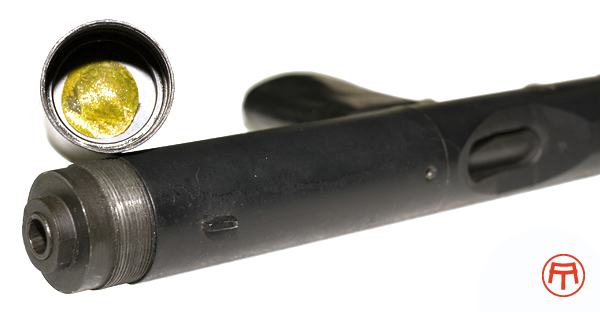
9mm Welrod Mk.I. with the suppressor unscrewed. Notice the vax paper seal showing us that this is a new silencer ready for use. (Photo - Anders Thygesen courtesy of the Royal Armouries).
The advantage to a detachable suppressor part is obvious as this makes the weapon considerably easier to conceal. The pistol will function despite the front piece being removed; however the noise reduction will be non exsisting.
The few examples I have had the opportunity to examine have all been marked with a 5 digit serial number as well as the familiar “star and square” stamp under the receiver.
A brief description of the silencer assembly is as follows: The barrel is perforated with 12 .068 inch diameter holes, allowing the powder gases to escape into the expansion chamber surrounding the barrel. In this case the holes serve the purpose of preventing the bullets from going supersonic as is the standard of 9 mm Parabellum ammunition. The suppressor piece differentiates markedly from Mk II and Mk IIA. It consists of 2 washers made from Linatex and reinforced with a layer of canvas on one side. The discs must be placed with the canvas facing the breech end. Later versions had the washers without canvas attached and they look and feel like modern rubber chemical plugs. A metal baffle is placed on the canvas side and a compressed felt disc with a 13/32 inch hole and a metal baffle are placed on the upper side of the washer facing the muzzle end. In between is a metal spacer best described as a spool from a sewing machine perforated on the axis by 24 holes .104 inch in diameter. The spacer creates yet another expansion chamber for the gases to cool of in before passing through the last washer.
 X-ray of 9mm Welrod Mk.I. suppressor. (X-ray courtesy of INTAREX - The Netherlands)
X-ray of 9mm Welrod Mk.I. suppressor. (X-ray courtesy of INTAREX - The Netherlands)
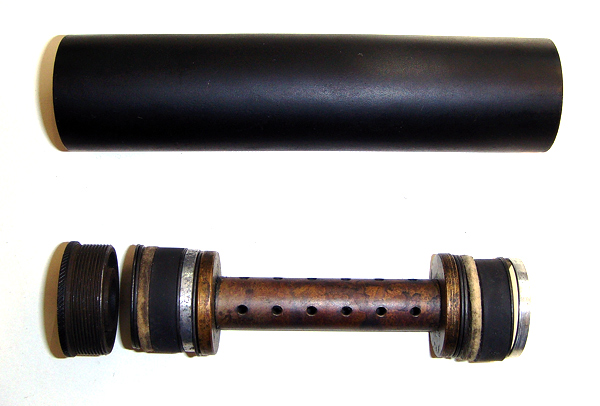 9mm Welrod Mk.I. suppressor field stripped. (Photo courtesy of INTAREX - The Netherlands)
9mm Welrod Mk.I. suppressor field stripped. (Photo courtesy of INTAREX - The Netherlands)
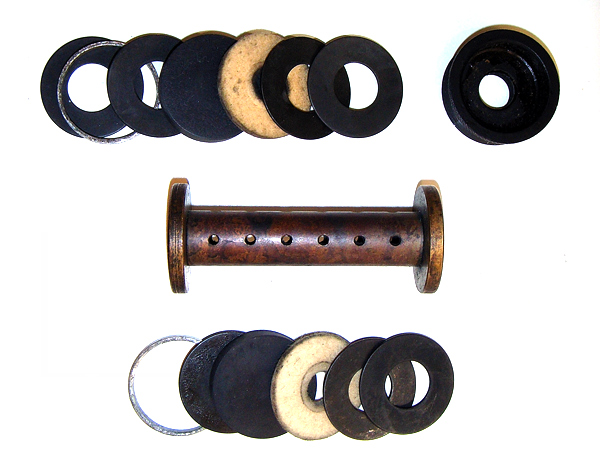 9mm Welrod Mk.I. suppressor field stripped. (Photo courtesy of INTAREX - The Netherlands)
9mm Welrod Mk.I. suppressor field stripped. (Photo courtesy of INTAREX - The Netherlands)
The muzzle velocity is approx. 1000 fps. Apart from the manually operated safety and the magazine release, the Mk I is operated and functions as the Mk II and Mk IIA. The iron sights are coated with a fluorescent material that, according the manual, renders the weapon efficient at 20 yards on a bright summer eve. The effective range in daylight is reported to be 30 yards. The recommended maximal shooting range is 24 yards.
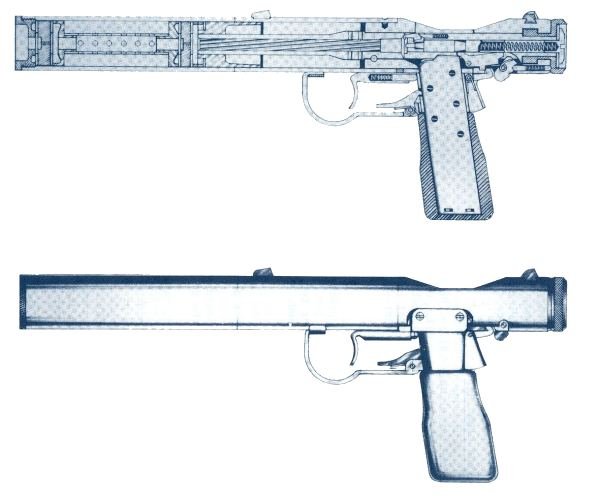 Diagram of Welrod Mk.l. (Drawing Joe M. Ramos - Canada)
Diagram of Welrod Mk.l. (Drawing Joe M. Ramos - Canada)
|
